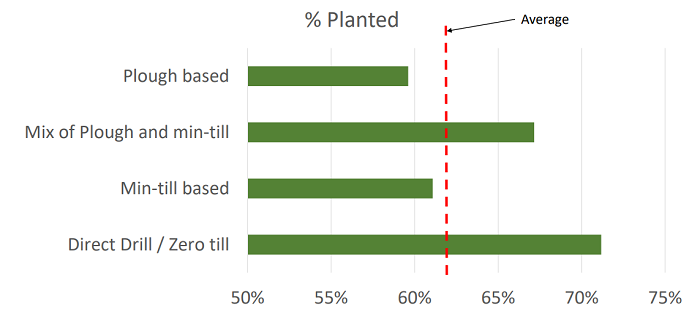01 February 2024
Survey results: 38% of winter area unsown

A survey conducted by the Teagasc Crops Department between December 18 and January 15 has highlighted the extent to which winter plantings have been delayed on tillage farms.
Collating data from 414 farms, operating on a total of 30,000ha, the survey monitored the areas sown in various regions, the establishment systems utilised and the farmers’ preferred crop choices when planted unsown ground this spring.
Reporting the survey results at the Teagasc National Tillage Conference on January 31st, Michael Hennessy, Head of Crops Knowledge Transfer at Teagasc, noted that an average of 62% of the planned winter area had been sown on respondents’ farms, with all establishment systems – plough-based, a mix of plough and min-till, min-till based, and direct drill / zero till – all being behind in terms of plantings. This unsown area is representative of ~80,600ha nationally.
On the establishment systems in play on the respondents’ farms, Michael noted that they were representative of farms nationally, as the majority were plough-based and only a small proportion operated direct drill / zero till systems.
Figure 1: Percentage of area planted by establishment system

Michael also gave an overview of the survey responses by location, noting that farmers in the south east and north east have less area planted. Survey respondents from Kilkenny, Wexford, Tipperary, Louth, Dublin, Meath, Westmeath and Offaly all have less than 62% of their area planted, the survey revealed. Another interesting finding is that very little variability exists in terms of the areas planted by farm size.
Figure 2: Percentage of area planted in each region

Additionally, Michael explained that farmers operating a mix of systems – a mix of plough and min-till – tended to have slightly more of their planned winter cereal area planted in three of the four regions assessed, but these farmers also reported a higher need to replant – potentially due to sowing later in less than desirable conditions and the wet conditions that followed after sowing.
For the area of winter crops not sown, farmers were asked what crops they would plant instead this spring. Some 47% of the respondents identified spring barley as their crop of choice, while winter wheat, beans/peas and spring oats accounted for 16%, 15% and 18%, respectively. Forage crops were the least favoured option, accounting for just 5% of survey responses.
Access Michael’s full presentation in PDF form from the Teagasc National Tillage Conference here.
Also read: Scale of seed shortage becomes apparent
